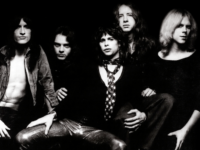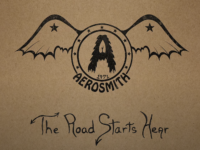Aerosmith finally achieved the superstar status they so rightly deserved with their third album, after half a decade of logging multitudes of miles on the tour circuit and cutting their self-titled debut and Get Your Wings – two fine but commercially unsuccessful LPs.
Arriving in stores in the spring of 1975, Toys in the Attic firmly demonstrated the industrious Boston band’s drive and determination to write and play hard rocking vigor on their own terms. It was was nothing short of brilliant, but Aerosmith’s Rocks provided even more fresh and exciting moments. Issued in May 1976, their next album was instantly hailed a masterpiece of its ilk, placing Aerosmith in the same lofty category as the Who, Led Zeppelin and the Rolling Stones.
Aerosmith were certainly a dynamic unit, as lead singer Steven Tyler, lead guitarist Joe Perry, rhythm guitarist Brad Whitford, bassist Tom Hamilton and drummer Joey Kramer brought a new feel and vibe to the genre they mined. But the pressures of fame eventually claimed the band and by the time they entered the studio in the summer of 1977 to lay down the eagerly awaited follow up to Rocks, focus and motivation were absent.
Arriving on Dec. 9, 1977, Draw the Line (Columbia Records) indeed proved to be a rather slovenly offering. Yet in hindsight, the album frequently fizzes with the kind of manic energy that punk bands of the day were peddling. Rather than polish and pamper their material and adopt a soft-rock approach as many of their contemporaries were doing at this point, Aerosmith were recklessly raw and ragged.
The strongest music on Draw the Line is easily found on the title track. Propelled by a fast-paced blues groove, pierced with slippery slide guitar action and a body-slamming hook, the romping rocker presents Aerosmith right in their element.
Other memorable numbers on the album include “Sight for Sore Eyes,” “Critical Mass” and “Get It Up,” as well as the spooky experimentation of “Kings and Queens,” which adds some banjo strumming and mandolin picking into the mesmerizing mix.
Not as sharp or concentrated as the band’s prior albums, Draw the Line tends to consist of overly slurred and blurred vocals and disorderly instrumentation, giving the impression that the project was a rushed affair. The beauty of real rock and roll lies in its spontaneity, however, and there is no doubt these songs rumble and stumble with such a devil-may-care attitude that fires the soul.
Draw the Line sold like hotcakes, but ended up garnering a lukewarm reception from both the media and some fans. Aerosmith was clearly hanging by a thread, and the album marked the end of their first phase of existence. It would be almost 10 years before all of the original members recorded together again.
A major comeback was ultimately staged, with Aerosmith not only being recognized as one of the greatest rock bands ever, but regaining their artistic mettle. In this next phase, they rebounded to create modern sounding music while still managing to maintain their blues rock-based roots.
- ‘Magic’ Wasn’t One-Hit Wonder Pilot’s Only Quirky, Radio-Ready Treasure - April 18, 2025
- How ‘Hollies Sing Hollies’ Showed New Promise After Graham Nash’s Exit - November 14, 2024
- Barry Melton on Country Joe and the Fish, Woodstock – and That Chant - August 15, 2024




